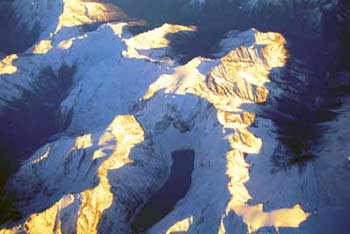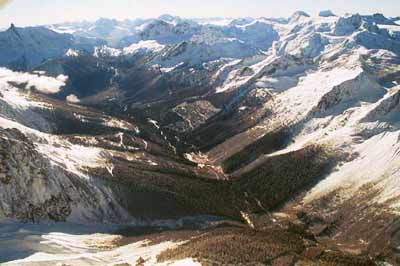|
||||||||||||
SummaryWestern Canada is an area with a most promising tourism potential. It was initially discovered as a tourism destination at the turn of the last century with the creation of the National Parks of the Canadian Rocky Mountains. At that time, the Canadian Pacific Railway Company initiated the Banff Springs Hotel and Chateau Lake Louise as long-term projects to serve tourists in the area. These projects are on going, and for almost a century have proven the strength of public demand for mountain resort tourism.
A more recent example began in 1986, when Intrawest, a then small private residential development company based in Vancouver, succeeded in buying the development rights and the assets of Blackcomb, one of the two mountains that constitute the resort of Whistler, B.C. Since then, Intrawest has transformed itself into the major ski industry developer in North America, becoming a public company, propelling Whistler into real estate development and acquiring a number of other resorts for development across North America. Despite the Intrawest success story, one can say that the tourist industry in North America is still in its infancy, and that this is particularly true regarding mountain and ski resorts. The growth of the ski tourist industry is blocked by lack of investment capital (unlike mining, forestry and technology it is not yet quite recognized as an industry by the investment community), by lack of suitable land and mountains, and by the length and uncertainties of the application process. The second reason may appear to be absurd in a continent the size of North America, but it is easily explained by the fact that most of the ideal areas for tourism were frozen into parks and conservation areas a long time ago, and by the fact that the remaining suitable mountains in good climate are difficult to access. Accessible mountains that are suitable for tourist resorts are difficult to find. Climate also restricts the regions where the best winter and summer tourism developments can take place. In addition, climate change is an undeniable reality and the current warming trend demands that viable ski resorts need to be located at higher elevations. The fact that most access roads only reach the main valleys that are too low and distant from high mountains and glaciers, however, make site selections even more difficult. Although the Rocky Mountains and adjoining mountain chains extend from Alaska to New Mexico and beyond, only British Columbia has large chains of mountains in ideal climatic conditions with glaciers, outstanding ski slopes and dramatic scenery. It is unlike Colorado, which has valley bases over 2,000 meters (6,560 feet). Vail and Aspen are above 2,500 meters (8,200 feet) in elevation. In the interior of British Columbia there are valley bases in the 1,500 meters (4,900 feet) range with peaks and glaciers in the 3,000 meters (9,850 feet) range, in ideal climatic conditions. This is where helicopter skiing was born. This is where, at least in one location, there should be a ski resort, if access could be found. History of the ApplicationIn 1990 a Japanese company commissioned the first study to locate and establish an ideal ski resort in North America. The study led to the identification of Jumbo Mountain and the Jumbo Creek Valley access as the sole area suitable for the development of a year round mountain and ski resort, due to its available access, its climate, its appropriate elevations, the availability of glaciers and conformity with government policies. And the unique location is the key to its unique economic viability. Unlike any other North American jurisdiction, the Province of British Columbia officially encourages and protects the rights of the applicant in similar projects by means of the Commercial Alpine Ski Policy (CASP) and of the more recent Environmental Assessment Act. The application has been encouraged by government authorities over the years and, despite the well known difficulties generated by the North American style of public processes dominated by the anti-development lobby, it has gone through nineteen years of studies and numerous steps of a complex process leading to:
The Proponent will now be able to complete the Master Plan approval process and a Master Development Agreement with the Province of B.C. according to CASP and proceed with the detailed permits and the development. The ProjectThe Jumbo Glacier Resort concept is to achieve a year-round facility focusing on sightseeing from the top of glaciers and a different kind of skiing in the mountains. It will allow the majority of the North American tourist population and the National Parks visitors to experience the nature and high alpine environment in a new way. Viewing the summits of mountains and vast high-altitude glaciers while being on them will be the ultimate experience. In the proponent's opinion, North America is ready for access by means of lifts to some of its many majestic glaciers in at least one location in the continent. The Glacier Dome location in particular is favoured by the unique view of the Lake of the Hanging Glacier in summer. The project will consist initially of a gondola, three glacier T-bars for winter and summer skiing, and two chairlifts. It will start as a day operation for sightseers and skiers from the area ranging from Calgary to Cranbrook, and particularly from Banff to Panorama, with the inclusion of a lodge and some individual accommodations for overnight visitors. A resort of 6,250 beds, including 750 beds for staff housing, is planned as a state of the art sustainable destination resort. It will be serviced by a network of lifts serving the most majestic accessible mountain area in North America, in a climate that will be superior to any other mountain resort in the world, and that is already well known for its heli-skiing in winter. Project Fundamentals1. Tourism is an industry of great potential for immediate economic growth and job generation in B.C. The public has indicated that these are important provincial objectives.
2. The temperate climate and unique land mass of mountains and glaciers in B.C. indicate that tourism in B.C. has the best potential if it is mountain-oriented, provided it is in the appropriate climatic zone, where sunny weather is prevalent and where year round skiing on glaciers is possible. 3. Skiing is the most important area of future growth for commercial tourism in the Province. B.C. has a record of continuous growth of skier days, however, skier days in B.C. are still about one half (1/2) of what they are in Colorado, despite greater potential in terms of skiable terrain and valley elevations. 4. Skiing needs a location where snowmaking is not necessary, the natural beauty of the mountains is an attraction, and the climate is right. 5. Glaciers are an advantage because in the right climate and elevation not only do they guarantee snow in winter, but they allow skiing in the summer, creating a year round season. The Jumbo Glacier Resort project is near the centre of a group of majestic glaciers at an elevation in the range of 3,000 meters (9,840 feet) and above. Jumbo Glacier and Commander Glacier meet at a saddle at 3,400 meters (11,150 feet). The Canadian Alpine Ski Team has requested to train on these glaciers in summer. 6. Locations are limited because large areas of mountains and glaciers have been set aside for parks and conservation areas, often in the most scenic and accessible locations. It is necessary, therefore, to select a location that is not pristine and not designated for protection. In this context, it is important to understand that the East Kootenay local C.O.R.E. land use plan facilitated by the Province confirmed the project, and approved it. It designated the area for project approval after the EA Act review and classified it as having "very high recreation and tourism, including resorts" values. The project was specifically mentioned as approved, subject to environmental review. 7. Proximity to infrastructure is also necessary to keep costs within a manageable range and to allow a variety of activities in the region nearby. The proposed location was formerly a sawmill site and has an existing road. It is only 35 kilometers (22 miles) from Panorama, B.C. 8. The Jumbo Creek Valley is the only area in North America that fulfills all of these requirements -- providing access to glaciers in the right climate and at the right elevations. In addition, Jumbo Mountain and Glacier Dome are a world class sight-seeing destination, comparable to the Jungfrau, or the Gornergrat railway arrival points in Switzerland. 9. Jumbo Glacier Resort will be unique in North America. Access to major glaciers is not offered anywhere on the continent except by means of helicopter. It will make access to glaciers affordable to the majority of people who are discouraged by helicopter transportation. This project will begin to modify the current situation where the majority of North Americans never see the spectacular scenery from the top of the western mountain ranges. 10. The Jumbo Glacier Resort concept is to achieve a year-round facility focusing on sightseeing and a different kind of skiing in the mountains, bringing a new experience of nature to the majority. Seeing the unique mountains while being on them will be the ultimate experience. Access by means of lifts to majestic glaciers in one location on the continent is the next threshold of mountain tourism experience. This project is comparable to the Gornergrat and the Jungfrau projects in Switzerland, one century later, as the leading mountain access project in North America. NEXT » Background
|
||||||||||||
|
Project Outline •
Gallery •
Documents Copyright © 1996 - 2010, Glacier Resorts Ltd. All rights reserved. |
||||||||||||

